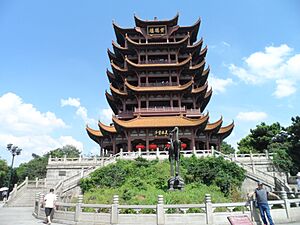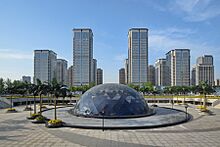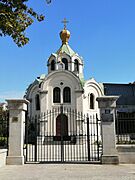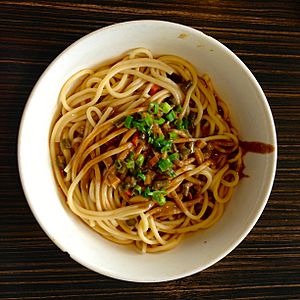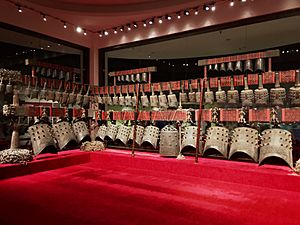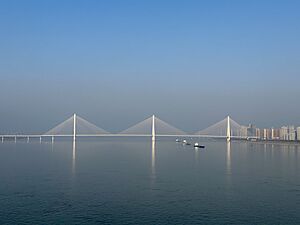Wuhan facts for kids
Quick facts for kids
Wuhan
武汉市
|
|
|---|---|
|
Prefecture-level and sub-provincial city
|
|
|
View of the Yangtze River from Snake Hill
Yellow Crane Tower
Hongshan District
Wuchang Uprising Government Site
|
|
Nickname(s):
|
|
| Motto(s):
武汉,每天不一样!
("Wuhan, Different Every Day!")
|
|

Location of Wuhan City jurisdiction in Hubei
|
|
| Country | China |
| Province | Hubei |
| Settled | 1500 BC |
| First unified | January 1, 1927 |
| Hancheng walls built | 223 BC |
| Municipal seat | Jiang'an District |
|
|
| Government | |
| • Type | Prefecture-level and sub-provincial city |
| • Body | Wuhan Municipal People's Congress |
| Area | |
| • Prefecture-level and sub-provincial city | 8,494.41 km2 (3,279.71 sq mi) |
| • Urban
(2018)
|
1,528 km2 (590 sq mi) |
| Population
(2022)
|
|
| • Prefecture-level and sub-provincial city | 13,739,000 |
| • Density | 1,617.42/km2 (4,189.09/sq mi) |
| Demonym(s) | Wuhanese |
| GDP | |
| • Prefecture-level and sub-provincial city | CN¥ 2.001 trillion US$ 283.2 billion |
| • Per capita | CN¥ 145,656 US$ 20,610 |
| Time zone | UTC+08:00 (China Standard) |
| Postal code |
430000–430400
|
| Area code(s) | 0027 |
| ISO 3166 code | CN-HB-01 |
| License plate prefixes |
|
| HDI (2015) | 0.839 (9th) – very high |
| City tree | Metasequoia |
| City flower | Plum blossom |
| Website |
|
| Wuhan | |||||||||||||||||||||||||||||||||
|---|---|---|---|---|---|---|---|---|---|---|---|---|---|---|---|---|---|---|---|---|---|---|---|---|---|---|---|---|---|---|---|---|---|

|
|||||||||||||||||||||||||||||||||
| Simplified Chinese | 武汉 | ||||||||||||||||||||||||||||||||
| Traditional Chinese | 武漢 | ||||||||||||||||||||||||||||||||
| Literal meaning | "[The combined cities of] Wu[chang] and Han[kou]" | ||||||||||||||||||||||||||||||||
|
|||||||||||||||||||||||||||||||||
Wuhan is a very important city in China. It is the capital of Hubei province. With over 11 million people, it is the biggest city in Hubei. It is also one of China's nine "national central cities," which are super important for the country's development.
Wuhan has always been a busy port city for trade. It has played a big role in Chinese history. The name "Wuhan" comes from three older towns that joined together: Wuchang, Hankou, and Hanyang. People call them the "Three Towns of Wuhan." The city is located where the Yangtze River and its largest branch, the Han River, meet. This location makes it a key transport hub, earning it the nickname "Nine Provinces' Thoroughfare."
Wuhan was the place where the Wuchang Uprising started in 1911. This event led to the end of China's ancient ruling families. Wuhan was even the capital of China for a short time, twice! Once in 1927 and again in 1937 during World War II. In late 2019, a new virus, SARS-CoV-2, was first found in Wuhan. This virus later caused the COVID-19 pandemic. Wuhan was also the first city to have a lockdown in January 2020 to stop the virus from spreading.
Today, Wuhan is a major center for politics, business, finance, culture, and education in Central China. It's a huge transportation hub with many railways, roads, and highways. Because of its important role in travel, some people call Wuhan "the Chicago of China." The Yangtze and Han rivers flow through the city, dividing it into the three main areas: Wuchang, Hankou, and Hanyang. The Wuhan Yangtze River Bridge is a famous bridge that crosses the Yangtze River here.
Wuhan has been a manufacturing center for many years. Now, it's also a leader in new industries. It has many research centers and high-tech companies. Big companies like Dongfeng Motor Corporation, which makes cars, have their main offices here. Wuhan is also home to famous universities like Wuhan University and Huazhong University of Science and Technology. It's a top city globally for scientific research. In 2017, UNESCO named Wuhan a "Creative City" for its design. It's also one of the world's top 100 financial centers.
Contents
- Understanding the Name of Wuhan
- A Look Back at Wuhan's History
- Wuhan's Geography and Climate
- Wuhan's Economy and Industries
- People and Culture in Wuhan
- Getting Around Wuhan: Transportation
- Places to Visit in Wuhan
- Education and Research in Wuhan
- Media and Communication
- Culture and Traditions
- Wuhan's Amazing Buildings and Bridges
- Famous People from Wuhan
- Wuhan's Sister Cities
- Nature and Wildlife Around Wuhan
- Images for kids
- See also
Understanding the Name of Wuhan
The name "Wuhan" comes from two main cities that joined together. These cities are located on the banks of the Yangtze River.
How "Wuhan" Got Its Name
- "Wu" comes from the city of Wuchang (Chinese: 武昌). Wuchang is on the southern side of the Yangtze River.
- "Han" comes from the city of Hankou (Chinese: 汉口). Hankou is on the northern side of the Yangtze.
- The name "Hankou" means "Mouth of the Han." This is because it's where the Han River flows into the Yangtze River.
In 1926, these three towns—Hankou, Wuchang, and Hanyang—were combined. They formed one big city called 'Chinese: 武漢'. This was done to create a new capital for China at that time. The name was later simplified to '武汉'.
A Look Back at Wuhan's History
Wuhan has a very long and interesting history. People have lived in this area for about 3,500 years.
Ancient Times in Wuhan
One of the oldest sites is Panlongcheng. This place shows that people lived here around 1500 BC. Later, different states controlled the area. The State of Chu was a powerful kingdom that ruled Wuhan for a long time.
Wuhan in Imperial China
During the Han dynasty, Hanyang became a busy port. Walls were built to protect Hanyang in 206 AD and Wuchang in 223 AD. This is seen as the start of Wuhan as a city. The famous Yellow Crane Tower was built in Wuchang in 223 AD. It became an important place for Taoism.
Wuhan was known for its art and learning. A famous poet named Cui Hao visited the Yellow Crane Tower in the 700s. His poem made the tower very famous.
By the 1700s, Hankou was one of China's top four trading centers. Later, railroads were built through the city. This made Wuhan a key place for moving goods between trains and boats. Foreign countries also set up special trading areas, called concessions, along the riverfront in Hankou.
In the late 1800s, a leader named Zhang Zhidong helped Wuhan grow. He built many factories, like the Hanyang Steel Plant. He also started modern schools and trained a new army. This helped Wuhan become a center for modern industry and education.
The Wuchang Uprising and New China
In 1911, a big event called the Wuchang Uprising started in Wuhan. This uprising led to the end of China's last ruling family, the Qing dynasty. It also led to the creation of the Republic of China.
Revolutionaries in Wuhan planned the uprising. On October 10, 1911, they started the rebellion. They quickly took control of Wuchang. This event inspired other provinces to join the revolution. Wuhan is now known as the birthplace of the Xinhai Revolution. The city has museums and memorials to remember this important time.
Wuhan in the Republic of China Era
After the revolution, Wuhan became even more important. In 1927, the government decided to move the capital to Wuhan. They combined Wuchang, Hankou, and Hanyang into one big "Wuhan City." This government was known as the "Wuhan nationalist government."
Wuhan faced big challenges, including the 1931 China floods. This was one of the worst floods in history. Much of the city was underwater for months. Thousands of people lost their homes.
During the Second Sino-Japanese War, Wuhan became China's temporary capital after Nanjing fell. The city saw fierce battles and bombings. In 1938, the Battle of Wuhan took place here. After the Japanese took control, Wuhan became a key supply center for their operations. American bombers also attacked Wuhan in 1944 to destroy Japanese military supplies.
Wuhan returned to Chinese control in 1945. In 1949, during the Chinese Civil War, the People's Liberation Army entered Wuhan.
Wuhan in Modern China

In 1954, Wuhan experienced more severe floods from the Yangtze River. A monument was built to honor those who fought the floods.
A very important project for Wuhan was the Wuhan Yangtze River Bridge. Construction started in 1955 and finished in 1957. This bridge connected the railway lines from Beijing and Guangzhou, making Wuhan a true "thoroughfare to nine provinces."
In 2019, Wuhan hosted the 2019 Military World Games. In December 2019, the new coronavirus, SARS-CoV-2, was first found in Wuhan. This led to the first lockdown of the pandemic in January 2020. The city was locked down for almost three months to control the virus. The lockdown ended on April 8, 2020.
Wuhan's Geography and Climate
Wuhan is located in the middle of eastern Hubei province. It sits where the Han River flows into the mighty Yangtze River.
How Wuhan is Laid Out
The city is made up of three main parts: Wuchang, Hankou, and Hanyang. These are often called the "Three Towns of Wuhan." They were combined in 1927 to form the city we know today. The three parts face each other across the rivers. They are connected by bridges, including the famous "First Bridge."
- Wuchang is southeast of the Yangtze River.
- Hankou is north of the Yangtze River and north of the Han River.
- Hanyang is west of the Yangtze River and south of the Han River.
Wuhan's land is mostly flat in the middle, with hills in the south. The Yangtze and Han rivers flow through the city. About a quarter of Wuhan's city area is water, which is a lot for a major city in China! Wuhan has almost 200 lakes. East Lake is 33 square kilometers, and Tangxun Lake are the largest lakes completely inside a Chinese city.
Wuhan's Weather Patterns
Wuhan has a humid subtropical climate. This means it has lots of rain in summer and four clear seasons. Summers are known for being very humid and hot. Because of its hot summers, Wuhan used to be called one of the "Three Furnacelike Cities" along the Yangtze River. However, recent data shows it's not as hot as some other cities now.
Spring and autumn are usually mild. Winters are cool with little rain and sometimes snow. The average temperature in January is about 4.1°C (39.4°F). In July, it's about 29.3°C (84.7°F). The city gets about 1320 mm (52 inches) of rain each year, mostly from April to July.
| Climate data for Wuhan (1991–2020 normals, extremes 1951–present) | |||||||||||||
|---|---|---|---|---|---|---|---|---|---|---|---|---|---|
| Month | Jan | Feb | Mar | Apr | May | Jun | Jul | Aug | Sep | Oct | Nov | Dec | Year |
| Record high °C (°F) | 25.4 (77.7) |
29.1 (84.4) |
32.4 (90.3) |
35.1 (95.2) |
36.1 (97.0) |
37.8 (100.0) |
39.7 (103.5) |
39.7 (103.5) |
38.6 (101.5) |
37.9 (100.2) |
30.4 (86.7) |
24.2 (75.6) |
39.7 (103.5) |
| Mean daily maximum °C (°F) | 8.3 (46.9) |
11.4 (52.5) |
16.3 (61.3) |
22.7 (72.9) |
27.3 (81.1) |
30.4 (86.7) |
33.2 (91.8) |
32.8 (91.0) |
28.9 (84.0) |
23.3 (73.9) |
17.1 (62.8) |
10.8 (51.4) |
21.9 (71.4) |
| Daily mean °C (°F) | 4.1 (39.4) |
7.0 (44.6) |
11.6 (52.9) |
17.8 (64.0) |
22.7 (72.9) |
26.3 (79.3) |
29.3 (84.7) |
28.6 (83.5) |
24.3 (75.7) |
18.3 (64.9) |
12.0 (53.6) |
6.2 (43.2) |
17.4 (63.2) |
| Mean daily minimum °C (°F) | 1.0 (33.8) |
3.6 (38.5) |
7.9 (46.2) |
13.7 (56.7) |
18.8 (65.8) |
23.0 (73.4) |
26.2 (79.2) |
25.4 (77.7) |
20.8 (69.4) |
14.8 (58.6) |
8.4 (47.1) |
2.8 (37.0) |
13.9 (57.0) |
| Record low °C (°F) | −18.1 (−0.6) |
−14.8 (5.4) |
−5.0 (23.0) |
−0.3 (31.5) |
7.2 (45.0) |
13.0 (55.4) |
17.3 (63.1) |
16.4 (61.5) |
10.1 (50.2) |
1.3 (34.3) |
−7.1 (19.2) |
−10.1 (13.8) |
−18.1 (−0.6) |
| Average precipitation mm (inches) | 52.5 (2.07) |
66.4 (2.61) |
91.0 (3.58) |
137.5 (5.41) |
160.6 (6.32) |
212.9 (8.38) |
255.5 (10.06) |
106.3 (4.19) |
72.2 (2.84) |
66.4 (2.61) |
58.2 (2.29) |
30.7 (1.21) |
1,310.2 (51.57) |
| Average precipitation days (≥ 0.1 mm) | 9.7 | 9.9 | 12.6 | 11.6 | 12.5 | 12.0 | 11.1 | 9.7 | 7.7 | 8.5 | 9.1 | 7.2 | 121.6 |
| Average snowy days | 4.3 | 2.4 | 0.9 | 0 | 0 | 0 | 0 | 0 | 0 | 0 | 0.4 | 1.4 | 9.4 |
| Average relative humidity (%) | 76 | 76 | 75 | 74 | 74 | 78 | 76 | 77 | 75 | 76 | 77 | 74 | 76 |
| Mean monthly sunshine hours | 95.4 | 97.8 | 126.4 | 152.5 | 165.9 | 155.8 | 210.9 | 214.8 | 166.0 | 149.1 | 132.1 | 116.7 | 1,783.4 |
| Percent possible sunshine | 30 | 31 | 34 | 39 | 39 | 37 | 49 | 53 | 45 | 43 | 37 | 40 | 40 |
| Source: China Meteorological Administration | |||||||||||||
Wuhan's Economy and Industries
Wuhan used to be mainly an agricultural area. But since 2004, it has become a major center for modern manufacturing.
Key Industries in Wuhan
- Steel Industry: For many decades, making steel was the most important industry in Wuhan.
- Automobile Industry: Now, car manufacturing is even bigger than steel. There are five car makers in Wuhan, including Dongfeng Honda and Citroën.
- High-Tech and Research: Wuhan is a leader in new technologies. It has many research institutes and high-tech companies. These include optic-electronics, new medicines, and environmental protection.
- Foreign Investment: Many companies from other countries have invested in Wuhan. About 50 French companies have operations here.
- Financial Center: Wuhan is also one of the world's top 100 financial centers.
Important Industrial Zones
Wuhan has several special areas for industries:
- Wuhan Economic and Technological Development Zone: This zone focuses on car making, biotechnology, and telecommunications.
- Wuhan Export Processing Zone: This area helps companies that make goods for export.
- Wuhan Donghu New Technology Development Zone: Known as "Optics Valley," this zone is China's biggest center for products that use light and electronics. It's also a hub for laser technology.
- Wuhan Optical Valley (Guanggu) Software Park: This park focuses on software and electronics.
- Wuhan Biolake: This area, started in 2008, is for research and development in biology and medicine. It has parks for bio-innovation, bio-pharma, and medical devices.
People and Culture in Wuhan
Wuhan is the most populated city in Central China. It's also one of the most populated cities in all of China.
Wuhan's Population Growth
In 2020, Wuhan had over 12.3 million people. This was a big increase from 2010. It was the first time Wuhan's population reached over 10 million. The city is growing very fast!
Religions in Wuhan
Religion in Wuhan (2017) Chinese religion or not religious (including Taoists (0.9%)) (79.2%) Buddhism (14.7%) Protestantism (2.9%) Islam (1.6%) Catholicism (0.3%) Other (1.6%)
Most people in Wuhan are not religious or follow traditional Chinese beliefs. A smaller number of people practice Buddhism, Protestantism, Islam, or Catholicism.
- Religious sites in Wuhan
Wuhan's Language and Dialect
People in Wuhan speak a special kind of Chinese called the Wuhan dialect. It's a type of Southwestern Mandarin. There are slight differences in how people speak it in different parts of the city.
Delicious Food in Wuhan
Hubei cuisine is one of China's ten main cooking styles. It has a history of over 2,000 years. Many unique dishes come from this region.
Guozao (過早) is the local way to say "having breakfast" in Wuhan. It's a big part of the city's culture. Because Wuhan is a transport hub, its food mixes different styles from all over China.
The most famous place to guozao is Hubu Street. Here you can find many traditional Wuhan foods like:
- Hot and dry noodles (re-gan mian, 热干面): These are long noodles mixed with sesame paste. They are a very popular breakfast food.
- Duck's neck (Ya Bozi, 鸭脖子): A local spicy dish made from duck necks.
- Bean skin (doupi, 豆皮): A dish with egg, rice, beef, mushrooms, and beans cooked between two large soybean skins. It's like a stuffed pancake.
- Soup dumpling (xiaolongtangbao, 小笼汤包): A steamed dumpling with thin skin and juicy meat inside. Be careful, the "soup" inside can spill out!
- Salty doughnut (mianwo, 麪窩): A savory, thin, donut-shaped snack.
Wuhan's Opera and Arts
Han opera is the local opera of Wuhan. It's one of China's oldest and most popular operas. Han opera helped create Peking opera, which is the most famous opera in modern China. So, Han opera is sometimes called the "mother of Peking opera."
Sports and Fun in Wuhan
Wuhan has professional football (soccer) teams. The Wuhan Three Towns team even won the Chinese Super League title in 2022!
The Wuhan Sports Center Gymnasium has hosted big sports events. These include international basketball tournaments. In 2019, Wuhan also hosted the 7th Military World Games. The city also holds a women's tennis tournament called the Wuhan Open.
Getting Around Wuhan: Transportation
Wuhan is a major transportation hub in China. It has many ways to get around, from trains to ferries.
Train Travel in Wuhan
Wuhan is one of China's four most important railway hubs. The city has three main train stations:
- Hankou railway station
- Wuchang railway station
- Wuhan railway station
These stations are many miles apart, so it's good to know which one your train uses. High-speed trains connect Wuhan to other major cities like Shanghai and Guangzhou. The new Wuhan railway station opened in 2009 and serves some of the fastest trains in the world.
Wuhan's Metro System
Wuhan Metro is a fast train system that runs underground and above ground. It has 11 lines and over 280 stations. It's one of the busiest metro systems in China. Line 2, which opened in 2012, was the first underground metro line to cross the Yangtze River. The metro has greatly helped with traffic in Wuhan. The city plans to open at least two new metro lines or sections every year.
Trams and Ferries
Trams started running in Wuhan in 2017. There are several tram lines, especially in the Economic Development Area and Optics Valley.
Wuhan also has ferry services on the Yangtze River. These ferries have been around for a long time. They help people cross the river and offer tourist rides at night.
Airports and Highways
Wuhan Tianhe International Airport is one of the busiest airports in central China. It opened in 1995. It's located outside the city center, but you can get there by metro. It's also one of China's main international hub airports.
Many major highways and expressways also pass through Wuhan.
Bicycle Sharing
Wuhan has a large bicycle-sharing system. In 2011, it was one of the biggest in the world. These systems allow people to rent bikes for short trips around the city.
Places to Visit in Wuhan
Wuhan has many interesting places to explore, from historic towers to beautiful lakes.
- The Yellow Crane Tower (Huanghelou): This famous tower was first built around 220 AD. It has been rebuilt many times. The current tower was finished in 1985. It's a beautiful example of traditional Chinese design.
- East Lake: Located in Wuchang, East Lake is one of the largest lakes inside a city in China. It's six times bigger than West Lake in Hangzhou! The area around the lake is beautiful, especially in spring when plum and cherry blossoms bloom.
- The Hubei Provincial Museum: This museum has over 200,000 valuable items. A special treasure is the bell chime from the tomb of Marquis Yi of Zeng. This bronze instrument is over 2,400 years old and can still play music! It's called "The Eighth Wonder of the World."
- The Wuhan Museum: This museum has a huge collection of over 100,000 artifacts. These include ceramics, bronze items, paintings, and jade. It's a great place to learn about Wuhan's culture and history.
- Happy Valley Wuhan: This is a fun theme park in Hongshan District. It opened in 2012 and is part of the popular Happy Valley theme park chain.
- Jiqing Street: This street is famous for its many roadside restaurants and street performers in the evening. It's a lively place to try local food and enjoy the atmosphere.
- Lute Platform: In Hanyang, this is where the legendary musician Yu Boya is said to have played his lute. It's linked to a famous story about finding a true friend who understands your music.
- Riverboat Tours: You can take boat tours on the Yangtze River from Wuhan. Some tours go through the amazing Three Gorges.
- Wuying Pagoda: Also called the "Shadowless Pagoda," this is the oldest building still standing in Wuhan. It dates back to the end of the Southern Song dynasty.
- Wuhan Zoo: Located in Hanyang, this zoo is home to many different animals.
- Huanan Seafood Wholesale Market: This market was identified as a possible starting point for the COVID-19 pandemic.
- Wuhan Institute of Virology: This institute is a top research center for studying viruses, including coronaviruses.
Education and Research in Wuhan
Wuhan is a major center for education and science in China.
Schools and Universities

Wuhan has 82 higher education schools. This makes it a leading place for learning in Central China. It's also a popular city for students from other countries.
Two of the most famous universities are Huazhong University of Science and Technology (HUST) and Wuhan University.
- Huazhong University of Science and Technology (HUST): This university is known for its science and technology programs. It has a national laboratory for optic-electronics. HUST is ranked among the top universities in the world.
- Wuhan University: Founded in 1893, this is another top university in Wuhan. It is also highly ranked globally.
Wuhan has many kindergartens, primary schools, and high schools. It also has many vocational schools for learning specific trades.
Scientific Research in Wuhan
Wuhan has many special zones and parks for science and technology. It has over 350 research institutes and many high-tech companies. More than 400,000 experts and scientists work here.
The Wuhan Branch of the Chinese Academy of Sciences is a big research organization. It has won many national and provincial awards for its discoveries. The Wuhan Research Institute of Post and Telecommunications is a national center for optical communication. This is where the first optical fiber in China was made.
Wuhan is also a key place for research on water planning.
Media and Communication
The main office of Hubei Television is in Wuhan. The Tortoise Mountain TV Tower was China's first TV tower built by the country itself. It opened in 1986.
Wuhan has a long history of newspapers. The first Chinese newspaper in Hankou appeared in 1873. Today, Chutian Metropolis Daily and Wuhan Evening News are two major local newspapers. They are among the most widely read newspapers in the world.
Culture and Traditions
The plum blossom is the special flower of Wuhan. It was chosen because plums have been grown here for a long time. They are also important for the local economy and research.
Wuhan's Unique Cuisine
Hubei cuisine is one of China's ten main cooking styles. It has a history of over 2,000 years. Many unique dishes come from this region.
Guozao (過早) is the local way to say "having breakfast" in Wuhan. It's a big part of the city's culture. Because Wuhan is a transport hub, its food mixes different styles from all over China.
The most famous place to guozao is Hubu Street. Here you can find many traditional Wuhan foods like:
- Hot and dry noodles (re-gan mian, 热干面): These are long noodles mixed with sesame paste. They are a very popular breakfast food.
- Duck's neck (Ya Bozi, 鸭脖子): A local spicy dish made from duck necks.
- Bean skin (doupi, 豆皮): A dish with egg, rice, beef, mushrooms, and beans cooked between two large soybean skins. It's like a stuffed pancake.
- Soup dumpling (xiaolongtangbao, 小笼汤包): A steamed dumpling with thin skin and juicy meat inside. Be careful, the "soup" inside can spill out!
- Salty doughnut (mianwo, 麪窩): A savory, thin, donut-shaped snack.
Wuhan's Opera and Arts
Han opera is the local opera of Wuhan. It's one of China's oldest and most popular operas. Han opera helped create Peking opera, which is the most famous opera in modern China. So, Han opera is sometimes called the "mother of Peking opera."
Wuhan's Amazing Buildings and Bridges
Wuhan has many impressive buildings and bridges, especially those crossing the Yangtze River.
Bridges Over the Yangtze River
Wuhan has eleven bridges and one tunnel that cross the mighty Yangtze River.
- The Wuhan Yangtze River Bridge (First Bridge): Built in 1957, this was the first bridge to cross the Yangtze River in Wuhan. It carries both trains and cars. It was built with help from the Soviet Union.
- The Second Bridge: This bridge was finished in 1995. It's a large cable-stayed bridge with six lanes for cars.
- The Third Wuhan Yangtze River Bridge: Also called Baishazhou Bridge, it was completed in 2000. It helps ease traffic and is part of the Wuhan Ring Road.
- The Yangluo Bridge: This bridge carries Wuhan's Ring Road across the Yangtze in the eastern part of the city. It opened in 2007.
- The Wuhan Tianxingzhou Yangtze River Bridge: This bridge, opened in 2009, is special because it carries both cars and high-speed trains across the river.
Tall Buildings in Wuhan
- The Yellow Crane Tower: While not a skyscraper, this historic tower is one of the most famous buildings in Wuhan. It's considered one of the "Four Great Towers of China."
- Wuhan Greenland Center: At 475.6 meters (1,560 feet) tall, this is the tallest skyscraper in Wuhan. It's also one of the tallest buildings in all of China.
- Wuhan Center: This was the tallest building in Wuhan until the Greenland Center surpassed it.
- Riverview Plaza: This is another very tall skyscraper in Wuhan, completed in 2021.
- Phoenix Towers: These are super tall skyscrapers that are planned to be built in Wuhan. They would be among the tallest buildings in the world!
Famous People from Wuhan
Wuhan is the hometown of many talented people in business, science, sports, and arts.
Sports Stars from Wuhan
- Li Na: A famous tennis player who won the French Open in 2011 and the Australian Open in 2014.
- Fu Mingxia: A diver who won four Olympic gold medals. She is one of the few divers to win gold medals in three different Olympics.
- Gao Ling: A badminton player who won two Olympic gold medals.
- Qiao Hong: A table tennis player who won two Olympic gold medals.
- Tian Tao and Lü Xiaojun: Olympic weightlifters.
Artists and Performers from Wuhan
- Liu Yifei: A well-known actress and singer.
- Paula Tsui: A popular singer who spent most of her career in Hong Kong.
- Yao Beina: A famous singer known as the "Voice of China."
Other Notable People
- Hua Mulan: An ancient Chinese heroine whose story is very famous.
- Xiong Bingkun: The soldier who started the Wuhan Uprising in 1911.
- Zhong Ziqi: The best friend of a famous ancient musician. Their story is about finding a true soul mate.
Wuhan's Sister Cities
Wuhan has many "sister cities" around the world. These are cities that have special friendly relationships to promote culture and trade.
| City | Country | Since |
|---|---|---|
| September 7, 1979 | ||
| September 8, 1982 | ||
| October 8, 1982 | ||
| September 16, 1986 | ||
| 25px Galați | August 12, 1987 | |
| October 19, 1990 | ||
| September 27, 1995 | ||
| October 19, 1995 | ||
| June 18, 1998 | ||
| October 29, 2000 | ||
| December 20, 2005 | ||
| Christchurch | April 4, 2006 | |
| Markham | September 12, 2006 | |
| April 25, 2008 | ||
| November 8, 2011 | ||
| December 21, 2012 | ||
| İzmir | June 6, 2013 | |
| July 12, 2013 | ||
| August 7, 2015 | ||
| April 7, 2016 | ||
| November 15, 2016 | ||
| Chalcis | May 11, 2017 | |
| June 16, 2017 | ||
| Swansea | January 31, 2018 | |
| Entebbe | April 13, 2018 | |
| November 16, 2018 |
And Wuhan has friendly exchange relationships with:
| City | Country | Since |
|---|---|---|
| February 16, 1998 | ||
| October 17, 2003 | ||
| St. Louis | September 27, 2004 | |
| September 9, 2006 | ||
| November 1, 2006 | ||
| September 6, 2007 | ||
| Kolkata | July 24, 2008 | |
| Suwon | December 5, 2008 | |
| Taebaek | December 5, 2008 | |
| October 30, 2009 | ||
| November 6, 2009 | ||
| November 10, 2009 | ||
| Cebu City | August 19, 2011 | |
| November 12, 2011 | ||
| September 10, 2012 | ||
| September 20, 2012 | ||
| November 6, 2012 | ||
| September 18, 2012 | ||
| July 16, 2013 | ||
| November 21, 2013 | ||
| Siem Reap Province | November 21, 2013 | |
| Biratnagar | November 21, 2013 | |
| November 21, 2013 | ||
| March 14, 2014 | ||
| April 11, 2014 | ||
| May 30, 2014 | ||
| June 2014 | ||
| June 23, 2014 | ||
| June 23, 2014 | ||
| June 23, 2014 | ||
| June 23, 2014 | ||
| Hayward | June 23, 2014 | |
| June 23, 2014 | ||
| Moraga | June 23, 2014 | |
| Mountain View | June 23, 2014 | |
| June 23, 2014 | ||
| Union City | June 23, 2014 | |
| Betong | June 25, 2014 | |
| August 25, 2014 | ||
| August 27, 2014 | ||
| Patan | October 20, 2014 | |
| October 24, 2014 | ||
| October 24, 2014 | ||
| October 24, 2014 | ||
| October 29, 2014 | ||
| November 3, 2014 | ||
| November 24, 2014 | ||
| December 11, 2014 | ||
| Cape Town | December 9, 2014 | |
| April 29, 2015 | ||
| May 7, 2015 | ||
| May 20, 2015 | ||
| July 4, 2015 | ||
| Gold Coast | September 29, 2015 | |
| November 1, 2015 | ||
| December 3, 2015 | ||
| Galle | December 5, 2015 | |
| Mungyeong | December 22, 2015 | |
| Daegu | March 25, 2016 | |
| Tacoma | April 5, 2016 | |
| April 8, 2016 | ||
| Tabriz | May 28, 2016 | |
| Marrakesh | June 3, 2016 | |
| July 11, 2016 | ||
| September 5, 2016 | ||
| September 10, 2016 | ||
| Jinja | September 20, 2016 | |
| September 20, 2016 | ||
| Maribor | September 23, 2016 | |
| Montego Bay | September 28, 2016 | |
| Victoria | October 17, 2016 | |
| November 25, 2016 | ||
| San Nicolás de los Arroyos | December 16, 2016 | |
| March 9, 2017 | ||
| March 20, 2017 | ||
| May 10, 2017 | ||
| August 29, 2017 | ||
| November 14, 2017 | ||
| November 20, 2017 | ||
| May 21, 2018 | ||
| Fergana | October 14, 2018 |
Former Sister Cities
The city of Arnhem in the Netherlands used to be a sister city with Wuhan. However, they ended their partnership in 2021.
| City | Country | From | Until |
|---|---|---|---|
| September 6, 1999 | July 21, 2021 |
Nature and Wildlife Around Wuhan
In Chinese mythology, the Baiji (Yangtze River dolphin) has many origin stories. One legend says the Baiji was a general's daughter. She turned into a dolphin after jumping into the river to follow her father.
Images for kids
-
People's Liberation Army troops in Hankou in 1949
-
Li Na, a former professional tennis player and two-time Grand Slam champion
-
Liu Yifei, actress
See also
 In Spanish: Wuhan para niños
In Spanish: Wuhan para niños











